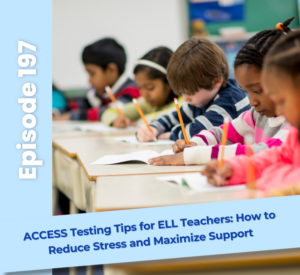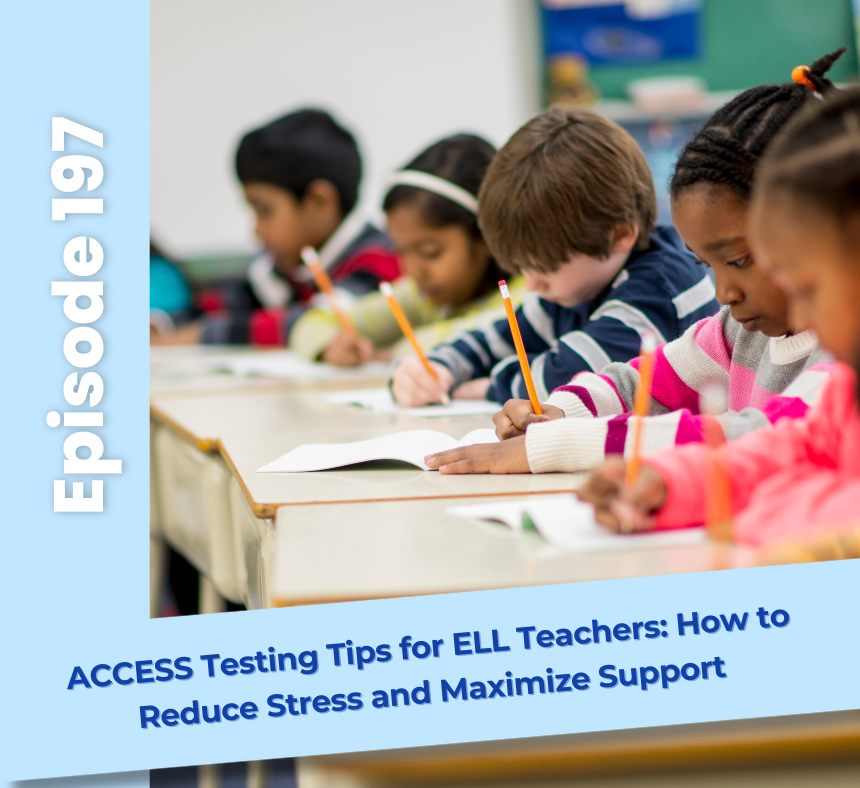
💡 What Is ACCESS Testing?
🎯 Why Test Prep Shouldn’t Mean “Drill and Kill”
- Familiarity with test format: Help students understand how the test works (especially if it’s digital).
- Confidence in their skills: Reinforce that they are more than a test score and remind them of how much they’ve grown.
🧑🏫 Step 1: How to Prepare Students for ACCESS Testing
- Tech readiness: Make sure they know how to log in, record answers, pause/resume tests, and navigate the platform.
- Use practice tools: Utilize engaging practice materials like recording prompts or interactive picture tasks.
- Focus on four domains: Continue embedding speaking and writing into daily lessons to build long-term proficiency.
- Visual support: Show students what testing will look like—where they’ll go, what the room setup is, who will be there.
- Encouragement activities: Have students create self-portraits or affirmations to celebrate their strengths.
- Keep prep brief but meaningful: A week or two of focused, intentional prep is all that’s needed.
🤝 Step 2: Collaborating with Homeroom Teachers
- Create a testing schedule: Use Google Sheets to share test dates and pull times.
- Set expectations early: Let teachers know how long testing will take and ask for flexibility.
- Send quick updates: Use pre-written email templates to notify teachers of student absences or test reschedules.
- Share support tips: Provide 4–5 simple ways teachers can continue supporting ELLs while you’re pulled for testing.
- Encourage collaboration: Frame testing as a team effort, with shared responsibility for student success.
🏠 Step 3: Keeping Parents in the Loop
- Use translated letters: WIDA provides pre-translated home letters in many languages—customize and send them home.
- Add visuals: Include icons or images showing sleep, breakfast, and a calm mindset to make instructions clearer.
- Clarify logistics: Mention when testing will occur, what students should expect, and how long it will last.
🧘♀️ Step 4: Taking Care of Yourself During Testing Season
- Adjust your expectations: You can’t do it all. Testing is time-consuming—give yourself grace.
- Ask for admin support: Loop in your administrators early to support scheduling and logistics.
- Stagger your testing schedule: If possible, test 2 days/week and teach the other days to avoid burnout.
- Organize your systems: Use spreadsheets, color-coded folders, and grade-level labels to stay on track.
- Have tech backups ready: Extra chargers, headphones, and working Chromebooks will save you headaches.
- Test the tech: Check compatibility between devices, headsets, and software ahead of time.
- Observe if you’re new: Watch a veteran teacher administer the test—it’ll make everything click.
✅ Tools That Can Make Testing Easier
- Editable email templates
- Visual prep guides for students
- Printable and digital test-prep centers
- Notes home in multiple languages
- A fully customizable ACCESS Testing Toolkit
📣 Final Thoughts: Advocate, Encourage, Empower
“Your students are more than a test score. And you are more than just the person giving the test.”
Connect with Beth:
More about Equipping ELLs:
We all know that teaching isn’t easy, but it doesn’t have to be this hard. Equipping ELLs is a podcast for both ESL specialists and homeroom teachers who are looking for effective and engaging ways to support their English Language Learners without adding to their endless to-do list. Tune in each week to hear tips, strategies, and inspirational stories that will empower you to better reach your ELL students, equip them with life-long skills, and strengthen relationships with colleagues and parents.
Your host, Beth Vaucher, is the founder of Inspiring Young Learners. She is an ESL certified homeroom teacher with over 10 years of experience teaching in the US and internationally. Her background of M.Ed in ESL and Curriculum and Instruction combined with her experience has led her to develop a bestselling newcomer curriculum that has sold in over 90 countries around the globe. She brings a different perspective to teaching ELLs from her years teaching and living abroad and working with ELLs from around the world. You will walk away from each episode with the ideas and tools you need to transform your experience as a teacher and cultivate a thriving and welcoming environment for your ELL students



